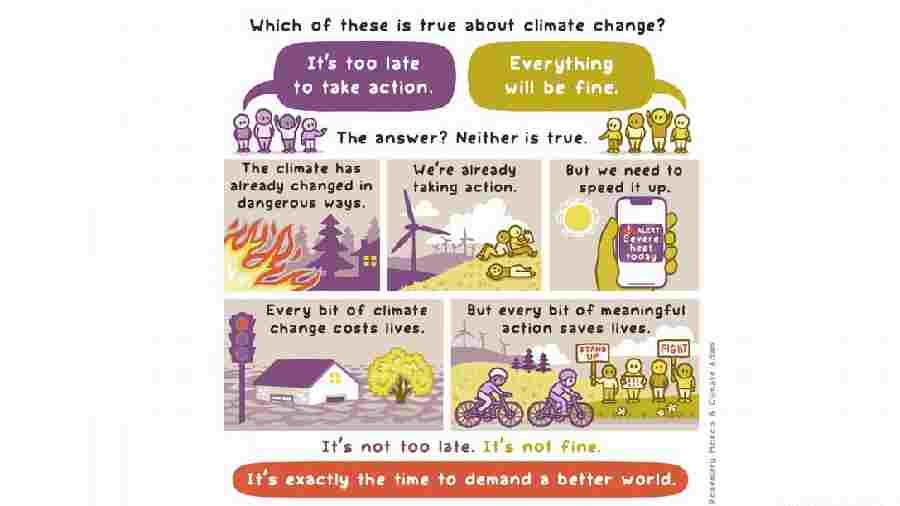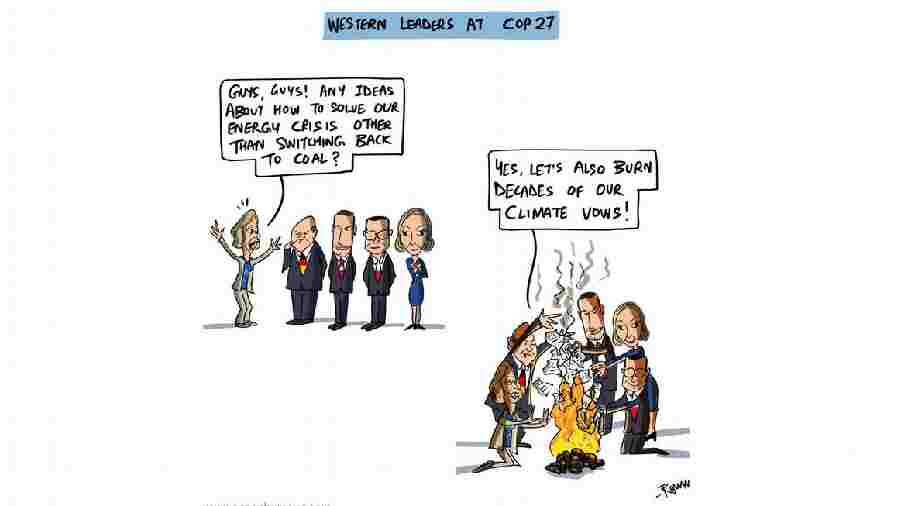The thermometer was touching 50 degrees Celsius (122 Fahrenheit) in the central Indian city of Nagpur as cartoonist Rohan Chakravarty spoke about how climate change influences his work.
The record-breaking heat wave — made 30 times more likely due to climate change — underscored the urgency of the topic.
He is one of a number of comic artists, using their comedic and creative talents to tackle inaction on climate change. Cartoons, like few other mediums, can condense complex scientific ideas into bite-size, entertaining forms that inspire action, without being too pious, researchers and cartoonists say.
Webcomic characters riff on climate change
Chakravarty's "Green Humour" comics span the spectrum of environmental issues. Think anthropomorphized animals wisecracking about climate change or serving concise satire of government failures, as well as large-scale informative breakdowns of complex topics.
"What started as a series that focused primarily on wildlife conservation grew to include all things green — how climate change affects people and agriculture, climate justice, the notion that social justice is tied to climate change and governance and policy," Chakravarty said.
He's drawn to the format of cartoons because they give the reader time to reflect and form their own opinion.
"That's the beauty of cartoons. This is a medium of communication that almost never gets preachy," Chakravarty said.
All this came in especially handy during the COVID lockdowns, when environmentalists in India were unable to publicly protest against government moves to drop environmental impact assessments for industries and corporations. Chakravarty said his comic became the face of the online movement against the proposed policy.
Cartoons catch people off-guard
The small number of academic studies on climate change and cartoons that exist suggest they enable creators and readers to explore dark ideas in meaningful ways. They can also help authors deal with stress or trauma they may have suffered as a result of climate disasters.
Graphic novels and cartoons can cut through where other mediums don't, said Nick Holm, a cultural and media theorist at Massey University in New Zealand. Holm's work focuses on popular culture as a way to understand political thinking.
"No one is on their guard reading the funny pages," he said. "I think the form is really powerful in that regard because it is a daily low-stakes form that is, at least ostensibly, primarily dedicated to entertainment. That's a very safe space to think about new things."
While Holm said they might not necessarily change every reader's view, humor perhaps "sets up better odds" for altering thinking on climate change.
A small contribution to the struggle
Rosemary Mosco, the artist behind the popular "Bird and Moon" comics, told DW that drawing comics allows her, in a small way, to help address climate change.
"None of us really knows exactly what to do, but we're all told by the experts to use whatever we have and to do what we can," she said from her US home. "I have cartoon skills, so it just seems natural to talk about what I care about."
Mosco's comics bounce from endearing facts about maligned species through in-jokes for bird-watchers to bitter truths on climate change.

Mosco says there's a long and successful history of people using comics to talk about deeply serious topics Deutsche Welle
Mosco feels too that injecting humor into a serious topic like climate change helps get the message across to a broad audience. She's had comics go viral on unlikely, ostensibly "boring" topics like bogs, and added that the medium doesn't detract from the seriousness of the issue.
"I think people understand that these are serious topics, that people are sort of whistling in the dark and making jokes because it shows our shared humanity and not because it belittles the subject."
Where is the line with humor?
Science communicators should keep in mind that there are risks to using humor, according to researcher Nick Holm. A society that finds humor in everything risks taking nothing seriously.
A prime example is the rise of online trolls and their constant search for "the lulz" — a play on LOL and a catchphrase used to justify often gratuitous behavior carried out for personal kicks.
He also cites "South Park's" early mocking of Al Gore's climate message in the "ManBearPig" episodes, which lampooned the idea of taking anything too seriously.
But, used effectively, humor can help build up earnestness, empathy and solidarity, and could help slowly change the political climate, so long as it doesn't devolve into outright mockery of those who disagree with you.
"Mocking climate change deniers is not going to get you anywhere. It's not going to convince anybody," he said. "It's going to alienate people. It's going to upset them. It's going to entrench them in their views."

Mosco tries to maintain a hopeful message in her climate change comics Deutsche Welle
The unfun comics
For Mosco, some of her most impactful comics lack any humor at all.
One shows just a wall of fossil fuel quotes meant to sow self-doubt and confusion among the public taken from various documents with a flame getting bigger and bigger in the background culminating in a forest fire.
But an overarching theme through her work is one of positivity. That it is not too late to act and that humanity cannot lose hope in the face of climate change.
And for Chakravarty?
"If I was to be entirely honest with you, the goal has always just been to go out and have fun, make some mischief, disrupt the status quo and see what happens."










